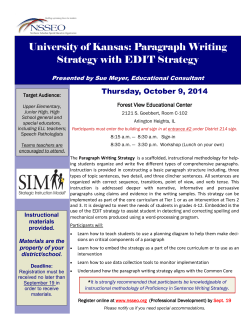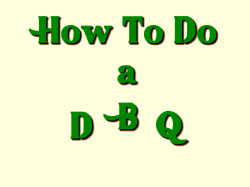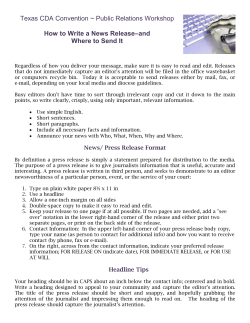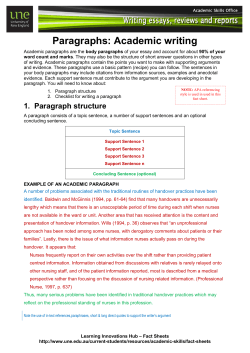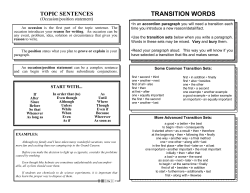
HOW TO WRITE A SCIENTIFIC PAPER Walter A. Zin, MD, DSc
HOW TO WRITE A SCIENTIFIC PAPER Walter A. Zin, MD, DSc Laboratory of Respiration Physiology Carlos Chagas Filho Institute of Biophysics Federal University of Rio de Janeiro What is a Scientific Paper ? A scientific paper is a written and published report describing original research results Writing a Research Paper • No single best way • Varies from paper to paper • Wait till data analyzed • Background reading - not too extensive - make notes; make notes of notes - write down sentences or parts of them - not during “writing time” Whom Writing For? • To please yourself? • Referees - to persuade the toughest one • Journal - Choose before writing - General vs. subespecialty journal Whom Writing For? Strategies to choose the journal: • Where many of the papers cited were published? • Where do cited scientists publish their work? • Read the avertising statements of journals • Read the “scope” paragraph in the “I for A” • Read the table of contents of potential journals • Examine several articles in potential journals Sequence • Fix realistic schedule (moderate) - Decision is final - Adherence foresees a good outcome • Figures, tracings, tables • Methods and Results • Discussion and Introduction • Abstract and Title Structure • A good article has a definite structure, makes its point, and does not was space and time • The most difficult part in writing a scientific paper is planning its structure Structure • Biggest problems come first • A scaffold of headings and subheadings • IMRAD: each on a separate sheet - In the first draft: random order, telegraphic style - Afterwards: the ideas must be numbered and an order generated Subheadings • Signposts to reader • Every paragraph in early drafts • Final version: never over single paragraph • Hierarchy of sub-subs - Max of 3 for typographical distinction Writing Tools • Dictionary, well-thumbed • Thesaurus • Synonyms, shades of meaning • Check every word • Pencil, pen, computer • Paper bin Methods Section • Enough information for an experienced investigator to repeat your work • Avoid tiresome detail • Cut-and-paste from previous work of the author(s), not somebody else’s • It is the first section of the paper in which subheadings should be used Results Section • Refer to data (Fig. X, Table Y) • Don’t repeat numbers in Tables • Can state numbers from Figures if precision is required • A lot of numbers, make Table Introduction 2-3 paragraphs, <450 words • First paragraph - Introduce broad area • Second paragraph - Explicit rationale • Last paragraph - Hypothesis Discussion Section • First paragraph - State major findings - Paraphrase abstract • Last paragraph - “In summary…” (2-3 sentences) - “In conclusion…” (biggest mensage, return to Intro, avoid speculation, avoid “need more work” Discussion Section • Middle paragraphs - Base each on a major result • Always focus on your results • Never discuss prior work without reference to your work • Refer Tables and Figures Abstract • Précis writing • Informative, not descriptive • Some numbers, but not in excess • Determines if paper will be read • Is distributed freely in databases Title • Max info in least words • <12 words • <100 characters • The title is a label • Should almost never contain abbreviations • Question: easier to understand, more impact • State results Figures • Do before writing • Redraw, redraw, prune clutter • Least non-data-ink • Max 4 lines, all solid • No caption • Reduce to 1 column in journal - Reduced xerox copy to check out - Original should be <3x final Figures • Axes - Minimize tick marks - Don’t number each tick • Lettering - Uniform, lower case - Minimize, avoid bold - After reduction, 2-3 mm high • Legend - Gives message Tables • Single unit, understood without text • Prune, prune: columns, lines • Exceed 1 sheet: redraw • Avoid narrow/broad; rotate all 90o • No added vertical/horizontal lines • If small: move data to text Of Writing • At assigned time: write (not read) • Don’t wait for the muses • A craft, not an art: practice • Ideas come while writing • Read good writers, especially non-medical Momentum • Fix a schedule • Monitor progress • Write by a biological clock • One page a week: torture • Skip trouble spots • Writer’s block: unacceptable Concentration • Need stretch of several hours • When time is short: prepare, revise • Avoid distractions: phone, beeper • Location - Very boring area - Nothing to distract First Draft • Write as quickly as possible • As if thinking out loud • Get everything down • Ignore spelling, grammar, style • Skip troublesome words • Correct and rewrite only when the whole text is on paper • Do not split the manuscript among the co-authors Good Writing • Content, accuracy • Clarity • Precision • Logic • Order of presentation Clarity • Clear • Exact - Ambiguity, inconsistency - Wooly words • Concise - Least words - Short words - One word vs many Simplify a majority of = most at the present time = now give rise to = cause in some cases = sometimes is defined as = is it is believed that = I think on the basis of = by pooled together = pooled subsequent to = after with the result that = so that Use and Misuse of English • Tense - Previously published work: present tense - Your own work: past tense • Voice - Active more precise and less wordy than passive - Name the agent, even “I” or “we” • Singulars and plurals Use and Misuse of English • Punctuation • Hyphens • Pile-ups of nouns or phrases • Numbers Bad Writing • Words don’t do justice to your ideas •If multiple mistakes in spelling and syntax, reviewer suspects similar sloppiness in the lab Style • Clear, orderly presentation • Reads comfortably • Science vs literature Writing • Reshape, refine, tighten up • Juggle words, change sentences around • Strengthen transition between sentences • Check narrative flow • After several drafts ask for a second opinion Writing: Clutter • All first drafs have too many words • Successive drafts: prune vigorously • Strip every sentence • Look for excessive adverbs, adjectives • Writing improves in proportion to deletion of unnecessary words Writing: Abbreviations and Acronyms • Liked by authors, hated by readers • Reading should not require a glossary • Unwieldy word occurring > 10 times Writing: Sentences • Only one idea in a sentence • Keep short: <20 words • Vary length • Long sentences: greater risk of grammatical error Writing: Paragraph • The unit of thought in a group of sentences • Subheading over each one in early drafts • Not too long solid block of printing (<125 words) • Long paragraph: bad Writing: Narrative Flow • Telling a story • Reader follows from start to end • Writing is sequential: logic is the glue • Sentences hold hands • Smooth transitions • Every step is inevitable Rewriting • Secret of writing is rewriting • Secret of rewriting is re-thinking Typing • Clean • Wide margins (2.5 cm) • On one side of the sheet only • Adherence to the style of the journal • Proofread, proofread, proofread Authorship • Decided as early as possible • Should include persons who: - Can defend the intellectual content, including data and conclusions - Must be willing to concede publicly any errors - In the case of fraud be willing to state publicly the nature and extent, and account for its occurrence Authorship: Criteria • All the following criteria should be met: - Generate at least part of the intellectual content (conception or design, data analysis and interpretation) - Drafting, reviewing or revising critically for important intellectual content - Final approval of the version to be published Authorship: Order • Some journals use the alphabetical order • Most of them assume an order based on each author’s importance to the study - The first author is primarily responsible for collecting and analyzing data, and writing - The last one, an established investigator, assumes the overall responsibility for the study - The middle authors are listed according to their order of importance to the study Authorship: Responsibilities The authors must comply with the following rules when submitting the manuscript for publication: • The manuscript is not under consideration elsewhere and the research will not be submitted elsewhere until a final decision has been made by the journal • The manuscript is a trustful, original work without fabrication, fraud or plagiarism • The authors have made an important scientific contribution and are familiar with the primary data • The authors have read the manuscript and take responsibility for its content, and understand that if the paper, or part of it, is found to be faulty or fraudulent, they share responsibility Authorship: Conflict of Interest • All funding sources supporting the work and all institutional or corporate affiliations of the authors must be acknowledged • The authors must certify that they have no commercial association that might pose a conflict of interest in connection with the submitted paper Benefits of Writing • Benefit greater to author than reader • Invaluable mental discipline • Enhances clear thinking • Making a subject intelligible to others means you understand it • Improve your reading skills • Satisfies a creative instinct
© Copyright 2025
